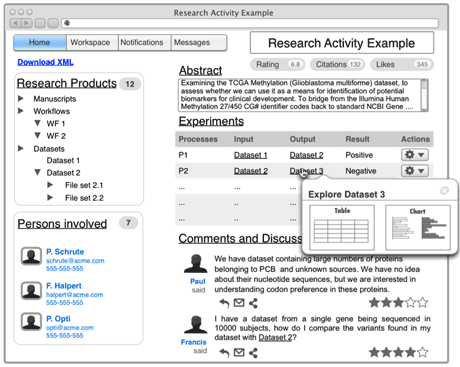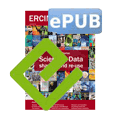by Massimiliano Assante, Leonardo Candela, Paolo Manghi, Pasquale Pagano, and Donatella Castelli
The purpose of data publishing is to release research data for others to use. However, its implementation remains an open issue. ‘Science 2.0 Repositories’ (SciRepos) address the publishing requirements arising in Science 2.0 by blurring the distinction between research life-cycle and research publishing. SciRepos interface with the ICT services of research infrastructures to intercept and publish research products while providing researchers with social networking tools for discovery, notification, sharing, discussion, and assessment of research products.
Data publishing approaches, namely the “data as a paper” ones [1], are mainly inspired by scientific literature communication workflows, which separate the place where research is conducted, i.e., Research Infrastructures (RIs), from the place where research is published and shared. In particular, research products are published “elsewhere” and “on date”, i.e. when the scientists feel the products obtained so far are sufficiently mature. In our opinion, this model does not fit well with other kinds of research products, for which effective interpretation, evaluation, and reuse can be ensured only if publishing includes the properties of “within” the RIs and “during” the research activity.
To enable effective scientific communication workflows, research product creation and publishing should both occur “within” the RI (as opposed to “elsewhere”) and “during” the research activities (as opposed to “on date”). To facilitate this, research infrastructure ICT services should not only be devised to provide scientists with facilities for carrying out their research activities, but also to support marketplace like facilities, enabling RI scientists to publish products created by research activities and other scientists to discover and reuse them. In other words, RIs should not rely on third-party marketplace sources to publish their products, but rather should integrate them into the RI.

Figure 1: Repo: An example of a SciRepo Activity Web Page.
Unfortunately, current repository platforms are not suitable to implement this vision, as they are designed not to integrate with existing RI ICT services but instead to support today’s notion of the “elsewhere” and “on date” research marketplace. We propose an innovative class of repositories: Science 2.0 Repositories (SciRepos).
SciRepos are characterized by the following features:
- Integration with RI ICT services in order to intercept the generation of products within research activities and to publish such products, i.e. making them discoverable and accessible to other researchers;
- Provision of repository-like tools so that scientists can access and share research products generated during their research activities;
- Dependence on social networking practices in order to modernize (scientific) communication both intra-RI and inter-RI, e.g., posting rather than deposition, “like” and “open discussions” for quality assessment, sharing rather than dissemination.
The SciRepo supports scientists with two kinds of end-user functionalities:
- Repository-oriented facilities: offering typical repository facilities on the information graph such as search and browse allowing search by product typology, but also permitting navigation from research activities to products and related products. Ingestion facilities are provided, allowing scientists to manually or semi-automatically upload “external” products into the repository and associate them with a research activity, thus including them in the information graph. Examples are publications, but also alternative scientific products, such as web sites, blogs, slides, documentation, manuals, etc. Ingestion allows scientists to complete the action of publishing a research activity with all products that are connected to it but generated out of the boundaries of the RI. The way scientists or groups of scientists can interact with products (access and reuse them) is ruled by clear rights management functionalities. Rights are typically assigned when products are generated in the RI or ingested by scientists, but can vary overtime.
- Collaboration-oriented facilities: offering typical social networking facilities such as the option to subscribe to events that are relevant to research activities and products, and be promptly notified, e.g., the completion of a workflow execution, the generation of datasets obeying to some criteria. Users can reply to posts and, most importantly, can express opinions on the quality of products, e.g., “like” actions or similar. This goes in the direction of truly “open” peer-review. More sophisticated assessment/peer-review functionalities (single/double blind) can be supported, in order to provide more traditional notions of quality. Interestingly, the posts themselves represent a special typology of products of the research activity and are searchable and browsable in the information graph.
In order to implement a SciRepo, RIs should develop their own software, thereby investing in a direction that requires different kinds of skills and dedicated funds. To facilitate this process we are designing and developing a SciRepo platform, devised to support the implementation of SciRepos at minimum development cost for the RIs. This platform builds upon previous works and experience [2][3].
References:
[1] L. Candela et al. “Data Journals: A Survey”, Journal of the Association for Information Science Science and Technology, 2014.
[2] M. Assante et al.: “A Social Networking Research Environment for Scientific Data Sharing: The D4Science Offering”, The Grey Journal, Vol. 10, 2014.
[3] A. Bardi and P. Manghi: “A rationale for enhanced publications”, LIBER Quarterly, 2014.
Please contact:
Massimiliano Assante
ISTI-CNR, Italy
E-mail:











